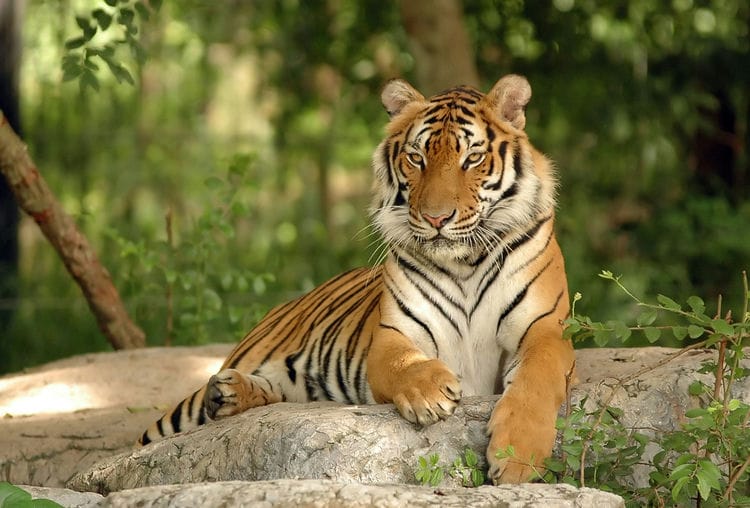MOVIE & LIFESTYLE NEWS
Do Tigers Live in the Rainforest? Exploring Their Habitat and Conservation Challenges
Tigers, known for their majestic beauty and powerful presence, are one of the most iconic big cats in the world. While these animals are often associated with dense forests and grassy savannas, one question frequently arises: Do tigers live in the rainforest? Let’s answer the question with AlibayTrendy Store now
Do Tigers Live in the Rainforest?
The answer is yes, but with some caveats. This article explores where tigers can be found and whether they call rainforests their home.
Tigers, among the most majestic and well-known of the big cats, are native to Asia, with their habitats distributed across a diverse range of countries. Their range extends from India and Bangladesh in the west, through Nepal and Bhutan, down to Thailand, Indonesia, and Malaysia.

This widespread distribution indicates the remarkable adaptability of these animals. Tigers are versatile creatures capable of thriving in a variety of environments, from the vast grasslands and savannas to the dense mangrove forests that dot the coastal regions.
However, their adaptability also allows them to inhabit more challenging and dense terrains, such as tropical rainforests. These dense environments offer a unique mix of cover and prey that makes them suitable for tigers.
Rainforests provide not only the resources needed for sustenance but also the seclusion required for raising cubs and avoiding human activity. This range of habitats demonstrates the tiger’s capacity to adapt and thrive across different environments, each offering unique opportunities and challenges.
Rainforest Tigers
Among the tiger subspecies that inhabit the rainforests, the Sumatran tiger (Panthera tigris sumatrae) is perhaps the most notable. This tiger is native to the Indonesian island of Sumatra, where it has uniquely adapted to the thick, humid, and often unforgiving environment of the tropical rainforest.

The Sumatran tiger is smaller and more agile compared to its cousins in other regions, allowing it to navigate through dense underbrush and climb trees with relative ease. These adaptations give the Sumatran tiger an advantage when hunting prey or avoiding danger within the rainforest’s complex ecosystem.
Another prominent rainforest tiger is the Malayan tiger (Panthera tigris jacksoni), which resides in the southern part of the Malay Peninsula. Like the Sumatran tiger, the Malayan tiger has adapted to the dense vegetation and humid climate of the rainforest.
Its smaller size and agile build make it well-suited to the rainforest’s complex terrain. This ability to move stealthily through thick vegetation is a critical survival skill, allowing these tigers to stalk and capture prey in an environment where visibility is often limited.
These adaptations underscore the remarkable evolutionary paths these tiger subspecies have taken to thrive in their unique rainforest habitats. Despite their prowess, these tigers face significant threats from habitat loss and poaching, making their survival an ongoing challenge that requires focused conservation efforts.
The Importance of Rainforests for Tigers
Rainforests serve as essential habitats for various tiger subspecies, providing a complex and rich environment where these magnificent animals can thrive. The dense vegetation in rainforests creates a network of cover that allows tigers to stalk their prey effectively, giving them a strategic advantage during hunts.

This thick canopy and underbrush not only offer concealment for tigers as they pursue their food sources but also provide protection from potential threats, including human encroachment. Rainforests are also home to a wide range of animal species, which contribute to a diverse and abundant food supply for tigers.
From smaller mammals like monkeys and deer to birds and reptiles, the varied wildlife in rainforests offers a robust ecosystem that supports these apex predators. However, despite the natural resources available in rainforests, tigers face numerous threats that put their survival at risk. Deforestation, often driven by agriculture and logging, leads to significant habitat loss, fragmenting the once-continuous expanses of rainforest into isolated patches.
This fragmentation makes it harder for tigers to find food and mates, weakening their populations over time. Additionally, poaching, driven by the illegal trade of tiger parts, poses a severe threat to these animals, further reducing their numbers. Given these challenges, critical conservation efforts are needed to preserve the remaining tiger populations in rainforest regions.
Conservation Efforts in Rainforest Regions
Several organizations are working to protect tigers in rainforests. Conservation efforts focus on protecting tiger habitats, preventing poaching, and supporting local communities to reduce human-tiger conflicts. Programs such as anti-poaching patrols, habitat restoration, and community education aim to ensure that these majestic animals continue to thrive in their rainforest homes.

In summary, tigers do live in rainforests, with the Sumatran and Malayan tigers being prominent examples. These incredible creatures have adapted to life in dense tropical forests, yet their survival is at risk due to deforestation, poaching, and habitat fragmentation. Conservation efforts are critical to protect these magnificent animals and ensure they remain a part of Earth’s diverse wildlife.
If you’re inspired by the beauty and power of these rainforest tigers, show your support with a stylish Tiger Hawaiian Shirt from AlibayTrendy Store! Our shirts feature vibrant tiger-inspired designs, perfect for standing out while contributing to the awareness of tiger conservation. Visit AlibayTrendy Store today and make a bold statement while supporting a worthy cause!
